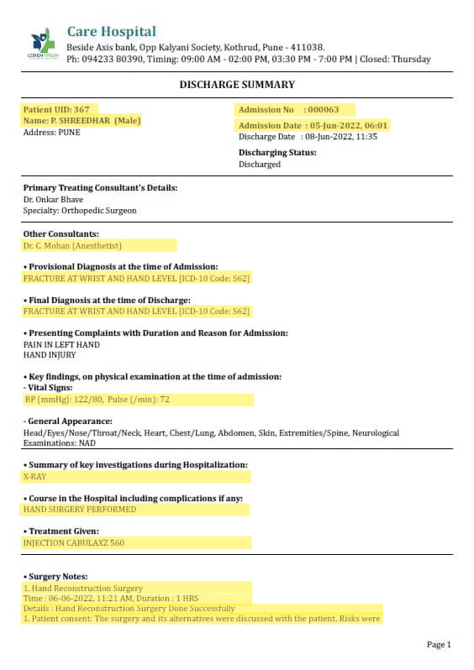The New Gold Rush: Why Your Business Needs to Focus on Critical Data Element (CDE) Extraction From Documents
In the age of information, data is often referred to as the 'new gold.' However, not all data is created equal. While businesses accumulate vast amounts of data through various channels, it's the Critical Data Elements (CDEs) that often hold the key to actionable insights and informed decision-making.
Equally important is the concept of Document Transformation, a process that converts unstructured or semi-structured data into a more accessible and usable format. But what happens when you combine these two crucial aspects? The result is a potent strategy that amplifies the value of your data manifold.
What are Critical Data Elements (CDEs)?
Critical Data Elements are specific pieces of data that have been identified as essential for various business operations, reporting, or decision-making. These elements are often the focus of data quality and management efforts due to their significant impact on the organization.
Examples of CDEs
- Customer IDs in a CRM system
- Transaction amounts in financial records
- Product SKUs in inventory management
- Patient medical history in healthcare databases, such as test Results, Treatment Summaries, or Discharge Summary (featured on the right)
CDEs are deemed critical for several reasons:
- They often serve as key identifiers or attributes in data models.
- They are integral to regulatory reporting and compliance.
- Errors or inaccuracies in CDEs can have severe repercussions, such as financial losses or compromised patient safety.
What is Document Transformation?
Document Transformation involves converting documents from one format or structure to another to make them more suitable for further processing or analysis. The process can include changing file types, restructuring data layouts, and even translating text from one language to another.
Types of Document Transformation
- Format Conversion: Changing the file type (e.g., Word to PDF or XML).
- Data Normalization: Making sure data is consistent and follows a specific standard (e.g., date formats).
- Text Extraction: Isolating useful information and removing unnecessary text or elements.
- Data Enrichment: Adding metadata or other supplementary information.
The Role of Document Transformation in Data Management
Document Transformation is an enabler of effective data management in:
- Preparing a structured Document of Record from unstructured or semi-structured data for analysis
- Automating data flows and reducing manual intervention
- Facilitating data sharing across different systems and platforms
While document transformation is a valuable process in its own right, its true potential is unlocked when you focus on Critical Data Elements (CDEs).
Benefit 1: Improved Decision-making
The quality of business decisions is often directly proportional to the quality of data on which they are based. By focusing on CDEs during document transformation, you ensure that the most crucial pieces of data are accurate, timely, and readily available.
For example, in supply chain management, CDEs like inventory levels, supplier reliability scores, and demand forecasts are essential for decisions related to stock replenishment, supplier selection, and production planning.
Benefit 2: Risk Management
Identifying and managing risks are central to the stability and growth of any business. CDEs often include data points that are vital for risk assessment.
In a financial context, CDEs like credit scores, transaction histories, and market indicators are indispensable for assessing credit risks or investment risks. Accurate extraction of these elements can spell the difference between a profitable venture and a costly mistake.
Benefit 3: Compliance and Reporting
Many industries are bound by strict regulatory guidelines that require the reporting of specific data elements. These are often CDEs, and inaccuracies or omissions can result in heavy penalties.
In healthcare, for instance, reporting accurate patient data is not just a regulatory requirement but also critical for patient safety. Transforming documents to accurately extract CDEs like patient IDs, medication dosages, and treatment plans ensures compliance and minimizes risks.
Benefit 4: Operational Efficiency
Operations often involve the handling of vast amounts of data, but not all of it is equally important. Focusing on CDEs can significantly streamline operational processes.
In the manufacturing sector, CDEs could include crucial data points like machine performance metrics, quality control results, and supply chain timelines. By targeting these Critical Data Elements, the manufacturing company can significantly enhance its operational efficiency, reduce costs, and improve product quality, which can ultimately result in increased profitability.
By concentrating your document transformation efforts on Critical Data Elements, you can substantially enhance decision-making, risk management, compliance, and operational efficiency. This targeted approach ensures you're not just gathering data for the sake of it but are focusing on the data that truly matters. This is why integrating CDE extraction into your document transformation process is a necessity for any data-driven business.
Identifying CDEs – 9 Point Checklist
Identifying Critical Data Elements (CDEs) is a crucial step in data management and analytics. This process often involves various departments and multiple stages of analysis to ensure that the CDEs selected are truly essential for the organization’s operational needs, strategic goals, or compliance requirements.
1. Understand Business Objectives
Alignment: Make sure that the identification of CDEs is aligned with the organization's goals and objectives.
Scope: Determine the scope of the business processes, operations, or projects where the CDEs will be used.
2. Involve Stakeholders
Inter-departmental Collaboration: Engage different departments (e.g., Operations, Finance, IT) to get a comprehensive understanding of what data elements are considered critical.
Consult with Experts: Consult domain experts, compliance officers, and data scientists to get specialized perspectives.
3. Conduct Data Inventory
Data Sources: List down all possible data sources where potential CDEs could be stored. This includes databases, internal documents, external feeds, etc.
Initial Categorization: Group data elements based on functionality, importance, or the department that uses them.
4. Analyze Business Processes
Process Mapping: Document the business processes and workflows to understand where data is used, transformed, or created.
Point of Use: Identify the points in the process where specific data elements become crucial.
5. Establish Criteria for Selection
Impact: How much does the data element influence business decisions or outcomes?
Compliance: Is the data element required for regulatory compliance?
Frequency: How often is the data element used in day-to-day operations?
6. Preliminary Identification
Shortlisting: Based on the established criteria, create an initial list of CDEs.
7. Validation and Refinement
Test Scenarios: Use real or simulated scenarios to validate the importance of each CDE.
Feedback Loop: Gather feedback from end-users and stakeholders to refine the list.
8. Documentation
Metadata: Record details like the definition of the CDE, format, source, responsible department, and any transformations it undergoes.
Data Dictionary: Include the CDEs in a data dictionary for future reference.
9. Ongoing Review
Periodic Audits: Regularly revisit the list of CDEs to update it based on changing business needs, regulations, or technological advancements.
Adlib’s CDE Extraction Technology
Adlib’s approach to CDE Extraction involved 2 critical steps to ensure accuracy and integrity of the extracted data.
Step 1: Document Pre-Processing and Creation of Document of Record
Adlib Transform ingests virtually any document type and converts it into 100% searchable content which is compiled and assembled into universal formats for further processing and compliant archival.
Read more about Why Documents of Record Are Critical For Regulatory Compliance >
Step 2: Extract, Classify & Deliver
Adlib leverages Machine Learning (ML) and Natural Language Processing (NLP) technologies to automate the extraction of CDEs from transformed Documents of Record, and performs additional steps like classifying the data according to pre-existing taxonomies and delivering the data into business applications for further action, such as RIM systems in Life Sciences, ALIM systems in Energy, Claims Processing systems in Insurance, EMR/EHR systems in Healthcare, or BI platforms across the industry.
Example: Automating the Extraction of CDEs from a Scanned Driving License
CDE to be extracted:
- Last Name
- First Name
- Address
- Date of Birth
- Sex
- Driving License Number
- Driving License Expiry Date
- State of Issuance
Challenges:
The scanned license is in a TIFF, static image format. Text is not machine-readable.
Adlib AI Process:
- The image is converted to text by leveraging Adlib's OCR
- The record is converted to 100% searchable, machine-readable and archive-ready Document of Record in PDF/A format.
- The document is processed by previously trained Adlib AI model to identify and extract all the relevant CDEs.
- The data is delivered into third-party business application for further processing
For many organizations this is a very manual process.
With Adlib's Data Extraction, the total process takes less than 30 seconds.
Final Thoughts
Targeting CDEs during document transformation offers a viable and effective approach to tame the overwhelming volume of data and turn it into an asset.
Remember, the goal isn't just to manage data but to manage it in a way that adds value to your organization. Implementing a proven way to unlock actionable insights in your organization’s volumes of documents is equivalent to mining for nuggets of pure gold! This is why we believe we are on the precipice of a new epoch in the digital era that will center around structuring the unstructured data and uncovering critical insights from it – or as we refer to it The New Gold Rush of the Digital Era.
Intelligent Data Extraction The Adlib Way
Adlib Software specializes in document transformation technologies, gaining the trust of major international companies. The accuracy and quality of our document processing, such as optical character recognition (OCR), document conversion and assembly are unparalleled in the industry.
AI-powered Data Extraction is not new to Adlib. We’re investing in creating language model frameworks that can be tailored for sector-specific taxonomies through a rapid prototyping method and extract the CDEs critical for your organization. These models quickly adapt to a sample set of your files, and with minimal manual verification, they continue to improve as more documents are processed.





